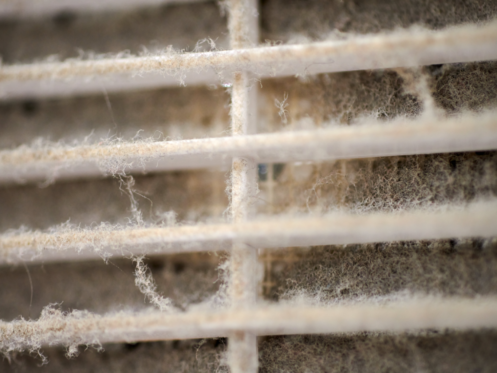In addition to keeping the condenser coils clean, homeowners also need to protect against dirty evaporator coils. Dirt and dust affects the evaporator unit in the same way as a dirty condenser unit. However it can cause additional damage like ice accumulation. With a frozen evaporator coil, typically the problem has existed for a while without being noticed. Preventive maintenance help protect against small problems that can lead to frozen AC coils.
Symptoms of a Frozen AC Coil
The most noticeable evidence of a frozen evaporator coil is the presence of water leaks. Moisture and condensation can build up and create leaks in your home. Another way to check is to feel the airflow from the registers. Depending on the severity of the problem, it could hinder the heat transfer process or stop the fan entirely. This can cause warm or no airflow coming through the registers. Make sure drapes, stray toys, or furniture isn’t covering or blocking the registers when checking them.
What Causes Frozen Evaporator Coils?
- Restricted Airflow: The most common issue is a dirty air filter. If the air filter is unable to let enough air through, the coils can get too cold. In addition, a clogged air filter won’t keep the dirt and dust out and it will accumulate on the evaporator coil and fan. This is why changing out the filter on a regular basis, typically every three months, is important. On the other hand, pets or high pollen counts often increase the frequency of replacing or cleaning a filter. Besides a dirty air filter, problems that can also create a lack of airflow include
- dirty fan blades
- a broken fan motor
- discarded foliage on the condenser unit
- Blocked Condensate Lines: Water from the humidity and condensation created during the cooling process can collect on the coils. These condensate lines drain accumulated moisture away from the coils to a floor drain. If the water isn’t able to drain away due to a clogged line or drain then it can turn into ice. From there, the problem can expand to affect other areas of the evaporator.
- Refrigerant Leaks: Refrigerant is the chemical used in the cooling process. As it runs through the evaporator coils, it absorbs the heat from inside the house and releases it outside. However a refrigerant leak will cause a lack of pressure. This will lead to the system spending more energy and the development of ice as a result of an improper cooling process. Leaking refrigerant can often be the source of a continuous hissing or whistling sound.
How to Fix Frozen Evaporator Coils
The system will need to be shut off in order for the ice to start melting. Depending on the severity of the accumulation, melting the ice from the coils will take several hours. Never attempt to chip off the ice as it could damage the evaporator coil! After all the ice is gone, you need to find the source of the problem. If the problem is a dirty filter then changing it out is a simple fix. However, it is best to call for a HVAC technician to handle clogs, leaks, or additional damage from ice build up.
Preventative Maintenance from Satterlee
Remember, costly repairs from frozen evaporator coils are avoidable! A seasonal HVAC maintenance from Satterlee can help catch problems early before they become costly. If you have any questions or would like more info about our services, contact us at Satterlee today.


